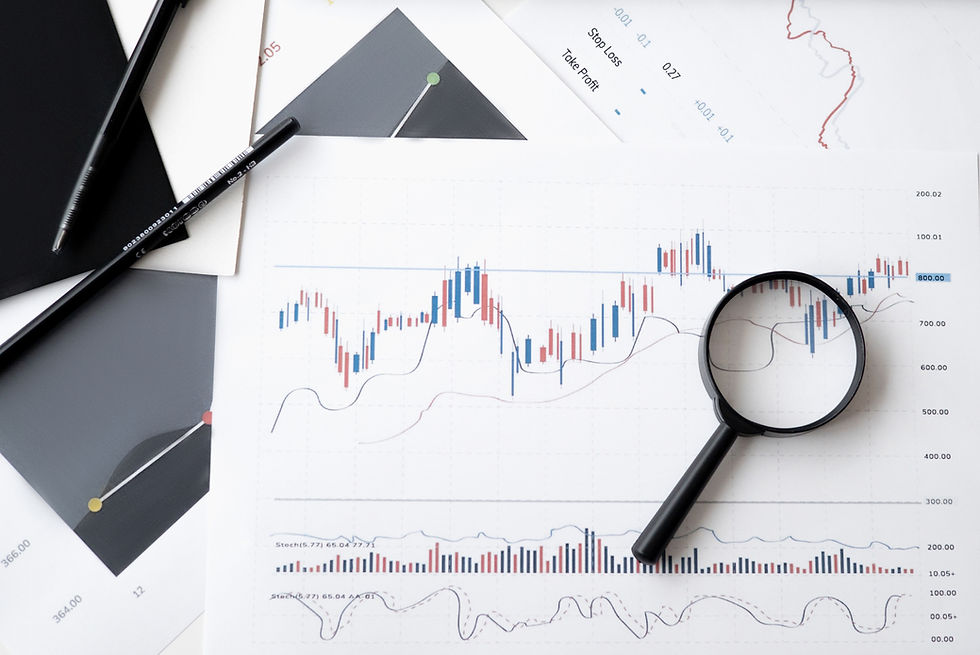The Basics of Backtesting
- Markets & Mayhem

- Nov 24, 2023
- 3 min read
Updated: Nov 24, 2023
Backtesting is a critical process in the development and evaluation of trading strategies. It involves simulating a trading strategy using historical market data to determine its potential effectiveness. Every trader should consider employing backtesting as a part of their overall approach to determining entries, exits, and risk management.
Understanding Backtesting
Definition and Purpose
Backtesting is the method of evaluating a trading strategy's performance using historical data. It serves as a crucial tool for validating a trading model without risking actual capital, akin to "swimming with a life vest".
Backtesting reveals how a strategy would have performed during past market conditions, thereby assessing its risk and profitability. It is not a crystal ball, it is instead about calculating probabilities and building a systematic approach towards managing execution.
Importance of Backtesting
Backtesting trading strategies is essential for several reasons:
It quantifies risk and return, providing insights into a strategy’s overall profitability and risk appetite.
It helps identify weaknesses, test resilience, and highlight areas for fine-tuning.
It offers a systematic approach to evaluate and enhance trading methods, allowing traders to understand their strategies better and set realistic goals.
Process of Backtesting
Preparation
Data Collection: Accurate and unbiased historical market data is essential. This includes price, volume, and other significant factors.
Strategy Definition: Clearly define the trading strategy, including entry and exit criteria, indicators, timeframes, and other relevant elements.
Execution
Software Tools: Backtesting can be conducted using various software tools, like Microsoft Excel, third-party platforms, or custom-built programs in languages like C++, C#, Python, or R.
Simulation: The historical data is used to simulate trades based on the strategy's rules. Performance metrics like profit and loss, win-loss ratio, risk-reward ratio, and maximum drawdown are calculated.
Evaluation
Performance Analysis: Assess the strategy’s performance over different periods and market conditions to ensure its reliability and mitigate the role of randomness.
Sensitivity Analysis: Investigate trends, strengths, and weaknesses in the performance data. Modify strategy parameters based on new information and perform sensitivity analysis to evaluate the impact of these changes.
Biases and Pitfalls
Common Biases
Optimization Bias (Curve-Fitting): Introducing extra parameters to inflate results, which can lead to poor real-world performance.
Look-Ahead Bias: Inclusion of future data in the simulation, leading to inaccurate predictions.
Survivorship Bias: Using datasets that don't represent the full range of relevant assets.
Psychological Tolerance Bias: Testing on long-term periods for improved performance, but planning to trade short-term.
Key Considerations
Ensure data quality and consider transaction fees, slippage, and market circumstances for realistic scenarios.
Avoid overfitting by not excessively optimizing strategies based on historical data.
Implement effective risk management strategies, including proper position sizing and stop-loss levels.
Comparisons and Conclusions
Backtesting vs. Paper Trading
While backtesting uses past data to evaluate a strategy, paper trading simulates trades in real-time settings without risking real money. Paper trading considers real-time execution challenges like slippage and market dynamics, unlike backtesting.
Measuring Success
Success in backtesting is not solely about returns but also involves analyzing returns in conjunction with adopted risk. Metrics like volatility, correlation among assets, and the Sharpe ratio are important to consider.
Backtesting Tools
All of the below backtesting tools are worth your consideration. Remember that there is a learning curve. Be patient, seek support when needed, and plan for time to learn the system, build your strategy, and test it thoroughly before executing on it.
Final Thoughts
Backtesting provides an invaluable insight into a trading strategy's potential effectiveness. It enables traders to make informed decisions, deepens understanding of market dynamics, and increases the likelihood of success in real trading situations.
However, it's essential to be aware of biases and to interpret backtesting results within the context of the overall market environment and individual trading goals.
When done properly, backtesting can help you to improve your confidence, discipline, and consistency. Taking a lot of the guesswork out of execution and keeping you away from impulse-driven trading decisions.

.png)



Comments